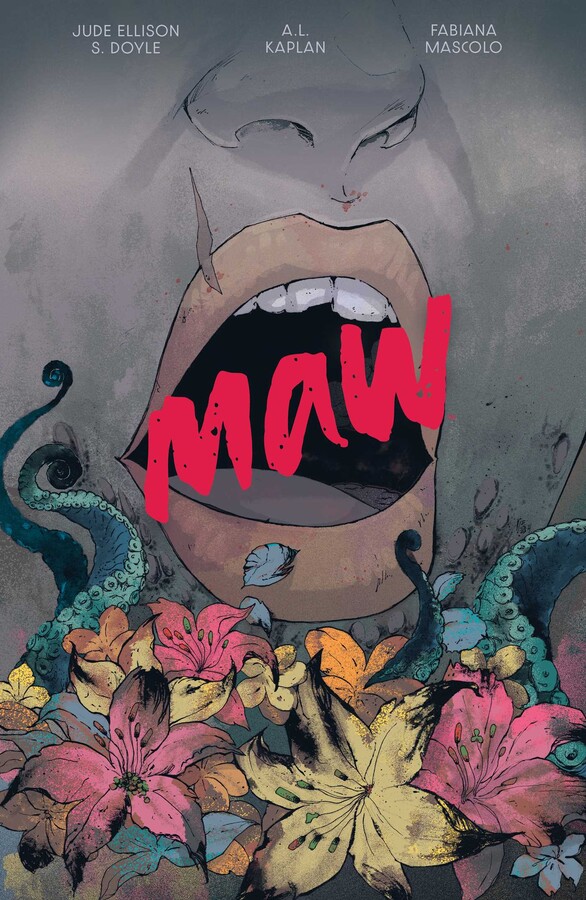A Politically-Charged Horror Trifecta: On “Maw”

I've been meaning to write about Maw for a few months now; it recently clicked for me as to how I might do that. And here we go...
*
Horror is relatively unique among genres in the way that it can envelop other genres under its broader auspices. Citing Stephen King as an example is probably an obvious move, but it gets the job done — and within the realm of King’s horror fiction you can find horror archetypes (Salem’s Lot), science fiction (The Tommyknockers), crime fiction (Misery), cosmic horror (Revival) — and some work that encompasses some or all of the above. Combine different genre elements within a horror story out of proportion and you get a mess; combine them in just the right amounts and you get something gloriously unsettling.
Maw — from writer Jude Ellison S. Doyle and artist A.L. Kaplan — falls distinctly in the second category. It takes its time revealing just which permutations of horror it contains, though. Part of the tension that Doyle summons up over the course of the book arises from the slow realization that, while this is certainly a story about a human’s body transforming into something monstrous, that’s far from all that it’s about.
The setup here is relatively simple, and opens with sisters Marion and Wendy en route to a retreat at a feminist compound. Marion describes the space’s founder, Diana Spiro, as “the wizard of feminism or whatever.” Wendy is optimistic about what the retreat might offer; Marion takes a more cynical attitude about the process, and leaves on the first night to go to a nearby bar. And it’s there that things begin to go terribly, terribly wrong.

While Marion is at the bar, a local man puts something in her drink, leading her to black out; when she wakes up on the beach, she assumes that she’s been raped. A brief flashback reveals that something similar happened to her recently, giving her an understandably cynical take on the ability of law enforcement and the judicial system to rectify such harm. (“The question was never whether they were guilty. The question was whether anyone cared,” Marion tells Wendy in the flashback.) This time, she opts to avoid the police.
If this book was simply about Marion reckoning with her own trauma, that would be one thing. But instead, things get strange. Marion begins to develop intense food cravings. Kaplan’s art features images of Marion pulling her skin, which begins to tear in places. Over the course of the book, Marion shifts from looking malnourished to looking like she’s undergoing a kind of transformation — throwing a not-insignificant element of body horror into the proceedings.
Doyle introduces a few subplots here as well, including Wendy’s flirtation with Howie, the man who drove the sisters to the commune and who describes himself as “the only guy who can enter her property without being axe-murdered by 70-year-old lesbians.” Howie, it turns out, has some secrets of his own. Also, he isn’t necessarily exaggerating when it comes to the axes; when Diana Spiro does show up on the scene, she is accompanied by two attendants, each of them wielding an axe that would make the Swiss Guards blush.
As the story edges towards the supernatural and then crosses the border into the uncanny, Kaplan’s art is up for the challenge, depicting both precise body language and ambiguous transformations with equal skill. Kaplan’s character designs are also memorable, from the sisters’ stark differences to Howie’s jitteriness to the way Miranda, who handles many of the day-to-day aspects of running the space, balances a cheery warmth with reserves of authority.
Maw abounds with big ideas above and beyond the currents of horror that run through it. That the book is set at a very particular type of retreat prompts some taut sociopolitical jousting between its characters, especially Marion and Miranda. Diana herself has a memorable scene late in the book where she discusses a kind of curdled radicalism — and the tendency of some in progressive circles to (at least historically) overlook misogyny and abusive acts in their heroes. And if you’re noting that some of Maw’s characters have names that resonate in literary history and mythology, you aren’t wrong to do so; Doyle is here both alluding to canonical works and subtly transforming them. It's what takes this narrative through its final permutation, and the personal and physical horrors give way to something even grander.
Marion’s voice is ultimately what leads the reader through this multi-layered story, and Doyle’s script keeps Marion’s constantly shifting emotions in the foreground. That’s another key element of writing a story that spans different forms of horror — the importance of rooting those stories in a believable character. Throughout the book, Marion’s reactions and decisions feel entirely understandable for the character as she’s been established — and that’s what makes this book resonate so deeply, down to its terrifying final image.
As always, I'm Tobias Carroll, and this has been Postcards From Komiksoj.
This newsletter is free, but if you’re so inclined, I have a page at Ko-Fi where you can buy me a (metaphorical) cup of coffee. My novel In the Sight is available here, and details on upcoming readings can be found here.
If you're interested in buying any of the books reviewed in these pages, most of them can be ordered via Bookshop.